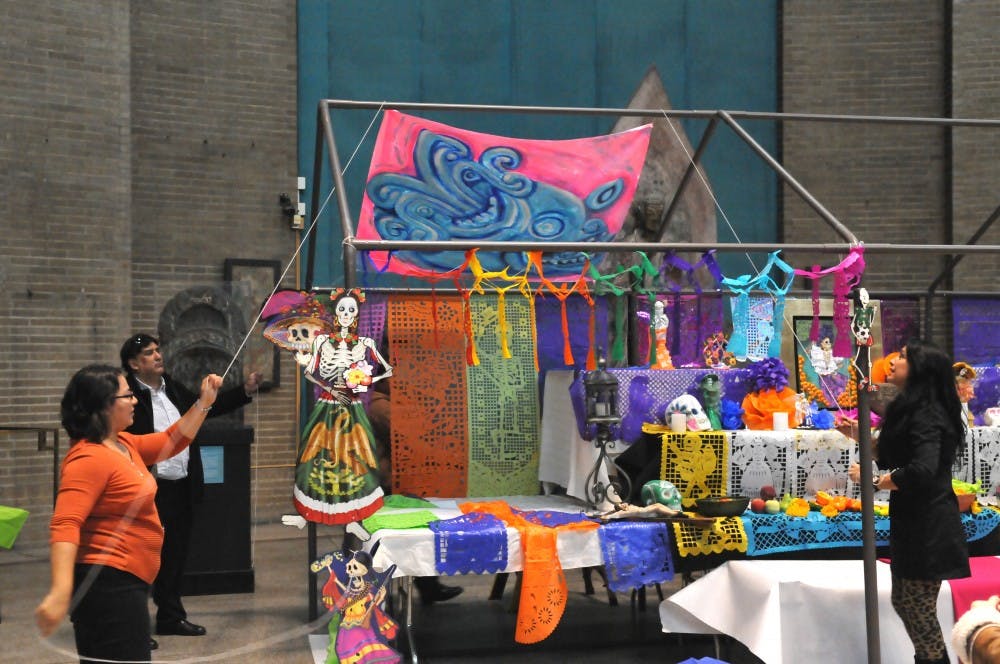
Just one day after Halloween, Mexican-Americans celebrate a ghoulish holiday of their own — the Day of the Dead.
Instead of costumes and going door to door for candy, an intricately decorated altar honoring the dead is the focus of this Mexican holiday.
This year, the University of Pennsylvania Museum of Archaeology and Anthropology invited Philadelphia muralist Cesar Viveros to create a Day of the Dead altar of his own.
Set to open to the public this Saturday, the museum exhibit showcases part of a tradition originating in Mexico that has spread throughout the United States.
In Mexico, the altars are traditionally set up in private homes or near family tombs and adorned with portraits of the dead alongside some of their favorite earthly pleasures, including cigarettes, food and alcohol.
“[The belief is that] for two days, there is a path to the other world that allows the souls to return and taste some of the things they used to enjoy,” Viveros said.
Those partaking in building the altars, however, also take great joy in mocking death, typically including in their creations a collection of skeletons dressed in ridiculous costumes ranging from a newlywed couple to a man on horseback to a dog.
Viveros said, “It’s about paying homage to the dead while you enjoy life.”
The museum altar will be unveiled to the public during a festival from 1 p.m. to 4 p.m. Saturday. La Casa Latina and Casa Monarca collaborated with the museum to bring traditional Mexican dancing, face painting and food to the Philadelphia community. A troop of dancers who specialize in pre-Hispanic dances will also be performing.
While the style Day of the Dead altars often differ from family to family, Penn Museum Events Coordinator Tena Thomason said all the altars venerate the dead in a distinctly irreverent manner.
Viveros’ altar complements the Penn Museum’s special exhibit on the Mayans and their apocalyptic legends.
Drawing upon a mixture of Mesoamerican and Hispanic cultural traditions, Viveros said the altar is “a mix of ancient beliefs and the Catholic religion.”
This dedication to festivity is as prominent an aspect of the holiday as the grisly reminders of death.
Viveros described the tradition as a celebration of food, color, smell and candlelight, a “mix of cultural, religious and pure artistic expression.”
Lent to Viveros by Mexican families living in and around Philadelphia, the offerings laid across the three-tiered altar form a lively display, well suited to the celebratory atmosphere.
“It’s going to be a great event celebrating Mexican, Hispanic and Latino cultures,” Jean Byrne, the Penn Museum Director of Community Engagement, said.
Matilde Dueñas, a board member of the Philadelphia-based Mexican Cultural Center, of which Viveros is president, said, “This altar is an example of the different cultures that are now in Philadelphia and that contribute to the richness of the culture of the city and the country.”
Viveros further emphasized the cultural significance of the holiday, explaining that his intent in preparing the altar was to keep the Mexican holiday tradition alive. “[I want visitors to] see color, feel, touch, smell [and] take with them something so different than Halloween,” Viveros said.
The Daily Pennsylvanian is an independent, student-run newspaper. Please consider making a donation to support the coverage that shapes the University. Your generosity ensures a future of strong journalism at Penn.
DonatePlease note All comments are eligible for publication in The Daily Pennsylvanian.





